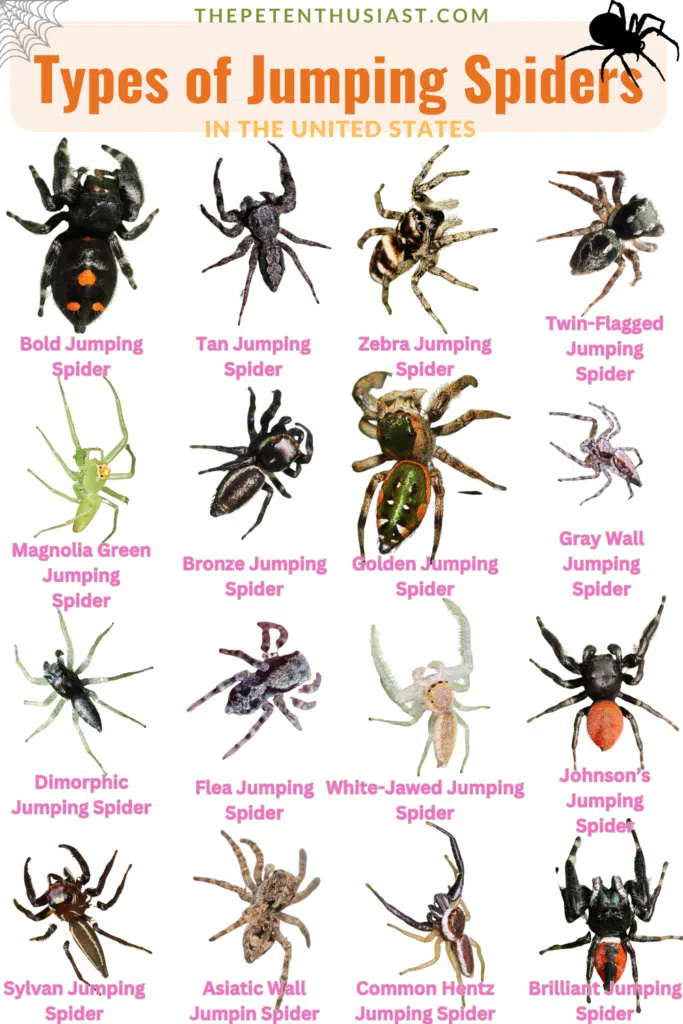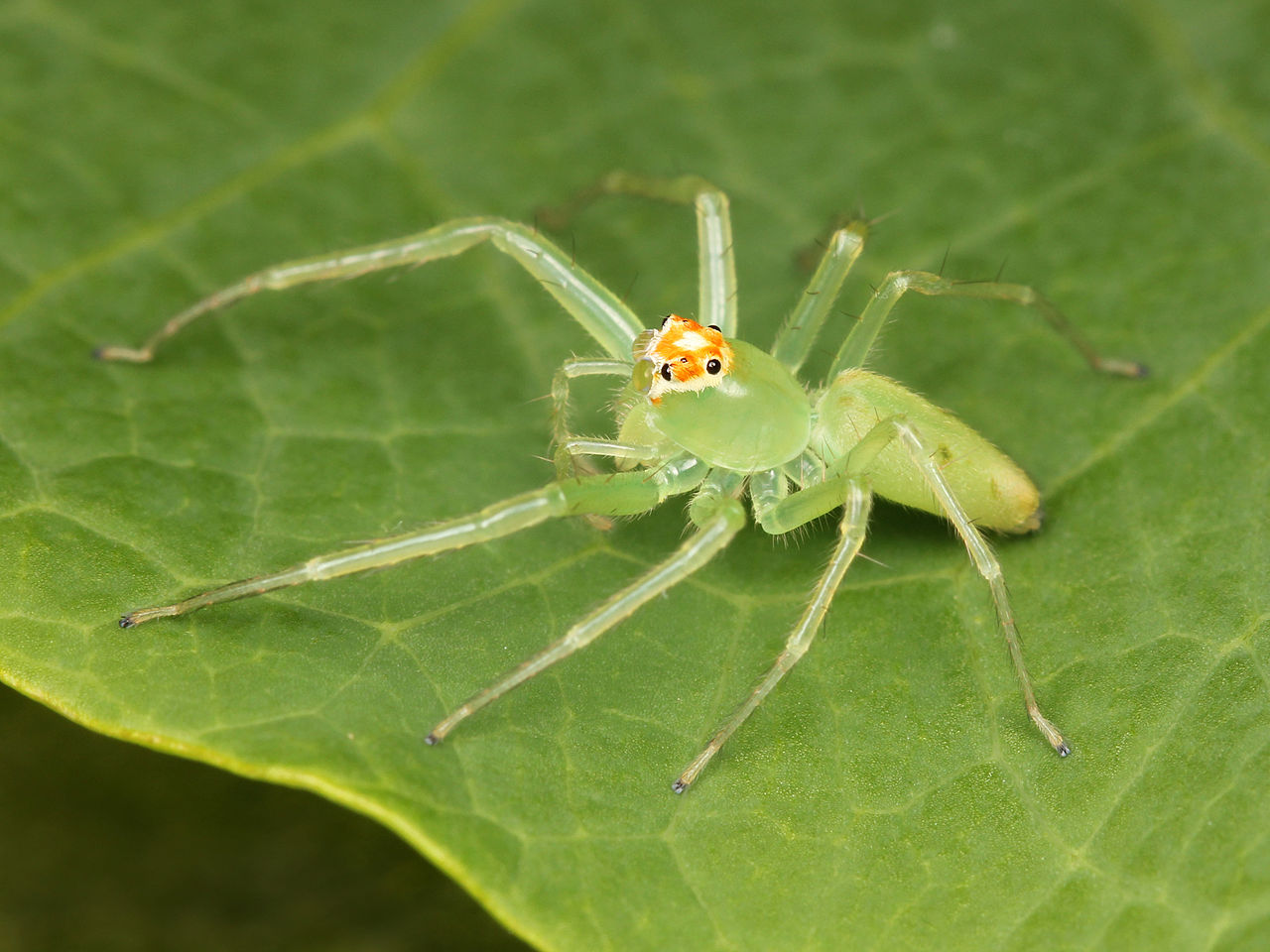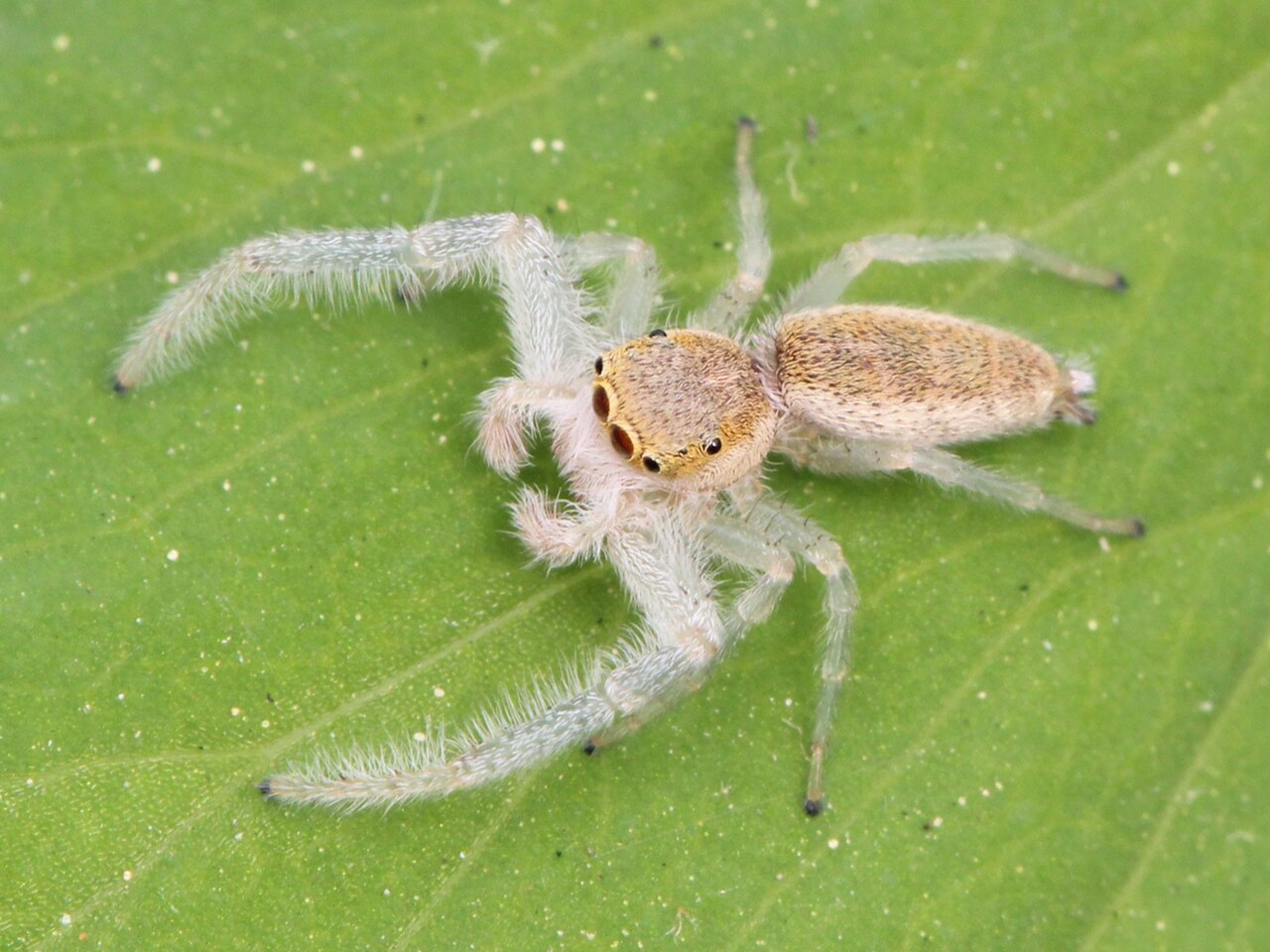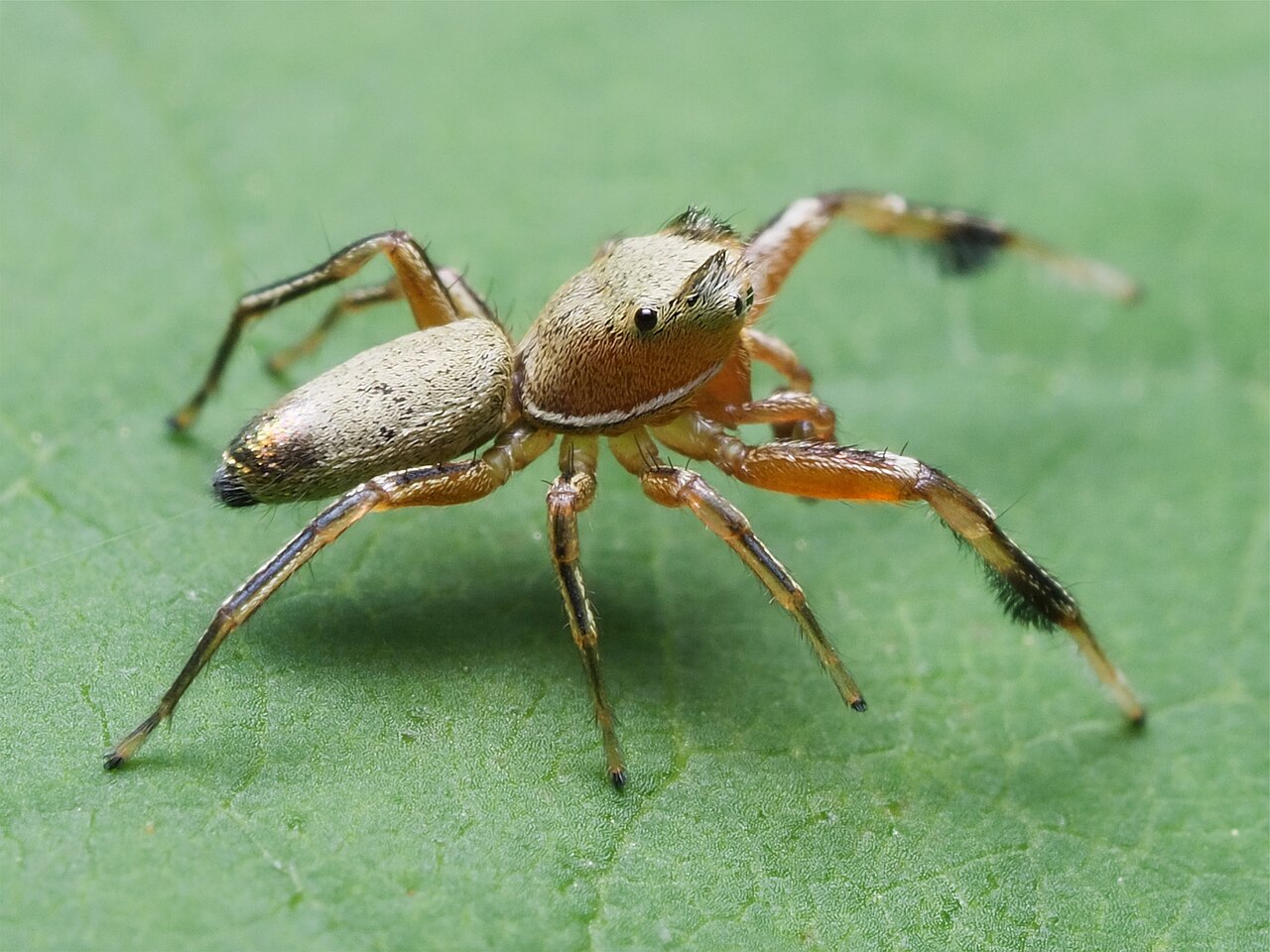Jumping spiders belong to the Salticidae family with over 6,000 described species, some of which can be encountered in the United States.
These spiders have the best vision, which is used for navigation, hunting, and courtship. They are agile jumpers that will jump in response to threats, covering long distances.
If you want to identify the jumping spider you encountered in your yard or home, continue reading to find out more about jumping spiders in the United States.
 Common jumping spider species in the United States
Common jumping spider species in the United StatesTable of Contents
1. Bold Jumping SpiderThe Bold Jumping Spider (Phidippus audax), often referred to as the bold jumper, is common in the United States. This spider has excellent vision which helps it stalk prey. These spiders are native to North America and have been introduced to Hawaii.
 Bold Jumping Spider
Bold Jumping SpiderThese black spiders have a white triangle on the abdomen. They are a solitary species and actively hunt and stalk their prey. They prey on insects, along with caterpillars, grasshoppers, dragonflies, and other spiders.
They are commonly seen in temperate climates, especially in open woodlands, agricultural fields, chaparrals, and grasslands. They are not a threat but they will bite if they feel threatened or you mishandle them.
Adult females can grow to 15mm in body length, whereas the males are smaller, growing to around 13mm in body length. They are black with a distinct white triangle in the center of the back and two small spots just below the triangle. There is a white band on the upper abdomen.
2. Tan Jumping Spider Tan Jumping Spider
Tan Jumping SpiderTan Jumping Spiders (Platycryptus undatus) have compressed bodies, allowing them to hide under the bark of trees. They have a chevron-like pattern on the abdomen, helping you identify them easily.
Females can grow to 13mm in body length, whereas males are smaller, growing to 9.5mm in body length. They prefer vertical surfaces including walls and fences. They seldom bite but will bite if they feel threatened.
You will encounter the tan jumping spider in North and Central America, from the Eastern States and Canada to Texas and Wisconsin.
3. Zebra Jumping Spider Zebra Jumping Spider
Zebra Jumping SpiderZebra Jumping Spiders (Salticus scenicus) are commonly seen in North America. They have a vivid black and white pattern. Females can grow to 9mm in length, whereas males grow to 6mm. These are small spiders with black-and-white hairs forming stripes.
They are often encountered in open habitats, including beaches, rock faces, and on tree trunks. They prefer open vertical habitats and are seldom far from humans. They are known to enter homes and are often seen on the windowsill.
4. Twin-flagged Jumping Spider Twin-flagged Jumping Spider
Twin-flagged Jumping SpiderThis small jumping spider (Anasaitis canosa) is often seen on leaf litter and man-made structures. It has two pennant-shaped markings on the dorsal side of the cephalothorax. They have iridescent scales which can be green, pink, or white.
These spiders grow to around 6mm in length with males being smaller than females. Males have smaller abdomens and darker appendages. Females are larger with large abdomens and uniform coloration.
5. Magnolia Green Jumping Spider Magnolia Green Jumping Spider
Magnolia Green Jumping SpiderThe Magnolia Green Jumping Spider (Lyssomanes viridis) is native to the United States and is found throughout most of the Southeastern United States. This is a small jumping spider with females growing to 8mm and males to 6mm in length.
They are translucent green with a small-scale fringe which is often orange, red, yellow, or white. The fringe is found on the crown of the head and frames the eyes. They can jump more than four times their body length.
They have brightly colored chelicerae. They wave their forelegs as visual displays. Fighting between males involves them pressing their forelegs and chelicerae against each other, pushing hard against each other until one retreats.
6. Bronze Jumping Spider Bronze Jumping Spider
Bronze Jumping SpiderThe Bronze Jumping Spider (Eris militaris), also known as the bronze jumper is found throughout the United States in rural and suburban areas. Males and females can be differentiated by their size and color.
Females have light cephalothorax and dark abdomens, with white spots. Males have light abdomens and darker cephalothorax with white bands on the sides. Females do not have white bands. This jumping spider can grow to 8mm in females and 6.7mm in males.
7. Golden Jumping Spider Golden Jumping Spider
Golden Jumping SpiderThe Golden Jumping Spider (Paraphidippus aurantius) is also known as the emerald jumping spider. It is a solitary hunter that is considered large for a jumping spider.
They are black or green with white side stripes on the head. There is a white border surrounding the abdomen. The white mid-line hairs have white dots and lines on both sides. They can be found throughout the United States.
8. Gray Wall Jumping Spider Gray Wall Jumping Spider
Gray Wall Jumping SpiderThis jumping spider (Menemerus bivittatus) is often found on the walls of buildings or on tree trunks. They are covered in short gray-white hairs with tufts of dark brown hairs near the eyes.
They grow to 9mm in length with males being smaller than females. Males have a black dorsal stripe with a white-brown stripe on the sides of the abdomen. The chelicerae and carapace are black and white. Females are brown with large abdomens and carapaces. Females have two black bands and a thin stripe on the carapace. The abdomen is edged with a black stripe on both sides.
This jumping spider is native to Africa and has been introduced to the United States. Today you can find it in Texas, Florida, and California.
9. Dimorphic Jumping Spider Dimorphic Jumping Spider
Dimorphic Jumping SpiderThis (Maevia inclemens) is a common and colorful jumping spider that can be encountered throughout North America. The males have two forms using different courting displays with equality success in mating.
The “tufted” form is black with three tufts across the head and pale legs. The “gray” form has black and white stripes over the legs and body with orange palps. This form does not have tufts. Females grow to 8mm and males grow to 6.5mm in length.
They have excellent vision with large main eyes in the front. The three smaller eyes are on the side of the head. The small eyes are responsible for the detection of motion. These spiders use their eyes for hunting, finding mates, and avoiding threats.
They are common in the eastern United States and south-eastern Canada. You will see them on main-made structures including fences and outbuildings. They have short, powerful back legs and large forelegs, which help them jump around four times their body length in a single leap.
The dimorphic jumping spider is sparsely covered in scales and hairs. The females are light brown with pale legs. There is a black band down each side of her abdomen. Some females have chevron markings in the center of the abdomen. There is a white stripe just before the eyes.
Males, on the other hand, are light to dark brown with a black edge line. Their eyes are surrounded by black. Both the males and females have a wide carapace.
10. Flea Jumping Spider Flea Jumping Spider
Flea Jumping SpiderThe Flea Jumping Spider (Naphrys pulex) is widely found throughout the United States and Canada. The males are mottled in gray and black on their abdomen, cephalothorax, and legs. There is orange on the sides of the cephalothorax.
This jumping spider is often seen in prairies, wooded areas, and tall grass. They are common in hardwood forests where leaf litter is abundant. You can sometimes find them inside buildings, on bark, or outcrops where they feed on arthropods and insects.
11. White-jawed Jumping Spider White-jawed Jumping Spider
White-jawed Jumping SpiderThe White-jawed Jumping Spider (Hentzia mitrata) is small and grows to 1/6 of an inch in length. Females are larger than males. These jumping spiders are light brown with copper hairs on the top of their heads. Pale white marks are seen on the edges of the legs and back.
They are completely harmless to humans and are not aggressive. These spiders are fascinating to watch. They do not spin webs; they use their excellent vision to hunt their prey.
The spider takes a high seated position, stalking the prey they find. They ambush their prey.
12. Johnson’s Jumping Spider Johnson’s Jumping Spider
Johnson’s Jumping SpiderJohnson’s Jumping Spiders (Phidippus johnsoni) are red-backed jumping spiders. They are one of the largest and most commonly encountered in western North America. They grow to approximately 1cm in length with bright red abdomens.
Females have a black central line. The chelicerae in both males and females are shiny and teal. The body is mostly black. These jumping spiders can be found from sea level to the tree line where they occupy dry habitats.
They construct tubular silken nests under wood and rocks. They remain inside at night and in bad weather.
13. Sylvan Jumping Spider Sylvan Jumping Spider
Sylvan Jumping SpiderFemales are 10mm with males being smaller at 9mm in length. Males are black with reds and yellows, while females are pale cream. There are prominent white stripes on the abdomen.
They (Colonus sylvanus) are commonly found hiding in shrubs in woodland areas. They do wander into homes now and then searching for prey. They are harmless to humans and tend to jump away if you approach them.
14. Asiatic Wall Jumping Spider Asiatic Wall Jumping Spider
Asiatic Wall Jumping SpiderThe Asiatic Wall Jumping Spider (Attulus fasciger) is native to western and northern Asia and has been introduced to North America. This brown-black spider has eight eyes with excellent vision used for hunting, courting, and avoiding predators.
They are small and can grow to 4mm in length. Males and females are similar in appearance. Males have a smaller abdomen than the female with larger palps.
15. Common Hentz Jumping Spider Common Hentz Jumping Spider
Common Hentz Jumping SpiderThe Common Hentz Jumping Spider (Hentzia palmarum) is small and uses an ambush technique to capture prey, rather than spinning a web. They can jump tremendous distances for their size.
When these spiders attack, they release a strand of silk, called a dragline. It attaches the dragline to the prey, which helps to reduce the risk of the prey escaping. They use their excellent jumping ability to escape threats.
They have dark red forelegs, that are long and larger than the rest of the legs, that are yellow. The pedipalps are also red, often thought to be a fifth pair of legs. They have large round eyes on the front of the face that are surrounded by an orange band of hair.
The brown-red on the head has a white hairy border. There is a border around the abdomen, along with dark banding over the abdomen. This spider hides among leaf litter, though they are known to make their way indoors when searching for prey.
16. Brilliant Jumping Spider Brilliant Jumping Spider
Brilliant Jumping SpiderThe Brilliant Jumping Spider (Phidippus clarus) is found in old fields in eastern North America. They wait upside down near the top of plants, helping to detect prey. Once the prey is detected, they jump down and capture their meal.
This is a large jumping spider that grows to an average of 4mm in width with a rectangular carapace. They are red-brown with some individuals being light yellow or brown with dark markings.
They live among flowers, sharing habitats with crab spiders.
17. Peppered Jumping Spider Peppered Jumping Spider
Peppered Jumping SpiderThe Peppered Jumping Spider (Pelegrina galathea) is native to North America where they can be seen in sunny grassy areas. They are black and white and have excellent jumping abilities. They can grow to 2.5cm in length.
They have four pairs of eyes with the main two on the front of the face being large. They are not dangerous and will jump away from threats. They will bite if they are mishandled or feel threatened.
18. Buttonhook Leaf-beetle Jumping Spider Buttonhook Leaf-beetle Jumping Spider
Buttonhook Leaf-beetle Jumping SpiderThe Buttonhook Leaf-beetle Jumping Spider (Sassacus vitis) is native to North America and grows to 5mm in length. Females are larger than males. They feed on small insects.
While they can be found throughout North America, they are most often encountered in California. They are glossy black or brown with white lines running across the front of the abdomen.
They actively hunt their prey, relying on their excellent vision to identify and catch prey. They are not a threat to humans.
19. Pantropical Jumping Spider Pantropical Jumping Spider
Pantropical Jumping SpiderPantropical Jumping Spiders (Plexippus paykulli) are native to southeast Asia and have been introduced to the United States. They are often seen in or around buildings where they sit by light sources, catching any insects attracted to the artificial light.
This robust spider has a high carapace and is covered in short gray hairs. Males have red accents. Females can grow to 12mm, whereas the males grow to 11mm in length. Males have black abdomens and carapaces with a wide central stripe and a white stripe on both sides with white spots at the end of the abdomen.
Females are brown-gray with a darker carapace. There is a wide tan stripe down the abdomen that separates into two chevrons. There are two white spots on both sides of the posterior. Juveniles are similar to females.
20. Putnam’s Jumping Spider Putnam’s Jumping Spider
Putnam’s Jumping SpiderPutnam’s Jumping Spider (Phidippus putnami) has four black tufts of hair above the eyes and more on the side of the head. They are often encountered in forests, parks, parking lots, gardens, and open fields. They are known to wander inside homes when searching for food.
They are not dangerous, though they are very curious and will investigate anyone that is observing them.
21. Ribbon Jumping Spider Ribbon Jumping Spider
Ribbon Jumping SpiderRibbon Jumping Spiders (Metacyrba taeniola) can grow to 7cm with females being larger than males. These spiders have a one-year lifespan. They are native to North America and can be found throughout the eastern United States.
They are active during the day and most of the year. They are often found in urban areas, making their way into homes searching for prey. They are small and black.
Females and males are similar in appearance with white, yellow, or cream lines that run down the back. The body is covered in small red-brown hairs. They have two large eyes with six small eyes circling the head.
They feed on insects using their excellent vision to find and track their prey. They stalk their prey before pouncing on them. They are not aggressive but they will fit if they feel threatened.
22. Grayish Jumping Spider Grayish Jumping Spider
Grayish Jumping SpiderThis jumping spider (Phidippus princeps) can be found in the eastern United States. Their average length is 12mm. Males are black with black and white fringes on the first pair of legs. There is a white band on the abdomen and a white triangular-shaped spot and oval spots on the posterior.
Females are larger and can grow to 22mm. They have the same color pattern as the males with black dorsal areas with colored scales. Colorful females are found mainly in Florida and the Greater Antilles.
23. Canopy Jumping Spider Canopy Jumping Spider
Canopy Jumping SpiderCanopy Jumping Spiders (Phidippus otiosus) are small and found in the southeastern and eastern coast of the United States. They prefer forests and are often seen around evergreens. They have white hair with black accents. Some are brown, orange, or a two-tone mix of colors.
They have metallic emerald green chelicerae. These ambush predators stalk and pounce on insect prey. They can capture insects larger than themselves. They are not harmful to humans and prefer to jump away from danger.
24. Common White-cheeked Jumping Spider Common White-cheeked Jumping Spider
Common White-cheeked Jumping SpiderThe Common White-cheeked Jumping Spider (Pelegrina proterva) can be found in the eastern United States. Females are larger than males, growing to 5.6mm, whereas males grow to 4.2mm in length.
They have rusty-brown carapaces with two wide white stripes on both sides. There is a striking white band across the forehead. Males are bronze with white stripes on both sides of the abdomen, whereas females are tan or yellow with black spots and white lines.
They have short legs designed for jumping. Males have black and white banded legs, whereas females’ legs are yellow with brown spots or circles.
25. Half-edged Wall Jumping Spider Half-edged Wall Jumping Spider
Half-edged Wall Jumping SpiderThe Half-edged Wall Jumping Spider (Menemerus semilimbatus) can grow to 8.4mm in length. Males are slightly smaller than females. They are considered large jumping spiders covered in short gray-white hairs. They have large forward-facing eyes.
The legs are light brown with dark rings and the abdomen is gray or yellow. There are several bright V-shaped markings.
These spiders prefer living in gardens and in and around houses. They are often seen on the walls of buildings stalking prey.
26. California Flattened Jumping Spider California Flattened Jumping Spider
California Flattened Jumping SpiderThe California Flattened Jumping Spider (Platycryptus californicus) creates a web as their home but they do not use it to capture prey. They are excellent ambush predators that drag their prey back to their web, consuming it later.
This small spider is not dangerous or aggressive to humans, preferring to run away if encountered. They will bite if they feel threatened, often due to mishandling. Their bite is no worse than a bee sting.
27. Regal Jumping Spider Regal Jumping Spider
Regal Jumping SpiderThe male Regal Jumping Spider (Phidippus regius) can grow to 18mm in length, whereas the females can grow to 22mm in length. It is not easy to differentiate the males from the females.
The males are black with white spots and stripes. Females have similar patterns to males, ranging in color from white to bright orange. They have three spots on the abdomen that looks like a smiling face. Males have white dots, whereas females’ dots range from white to orange, or cream.
They will only bite if they feel threatened. A bite from the Regal jumping spider results in localized swelling and pain. They are commonly found in open areas in the United States, including fields, woodlands, and the walls of buildings.
28. Whitman’s Jumping Spider Whitman’s Jumping Spider
Whitman’s Jumping SpiderThe male Whitman’s Jumping Spider (Phidippus whitmani) is red on the top with a black band in the eye region. Some have white hairs on the forelegs. The female is brown. They mimic multillid wasps, which are similar in size and color.
This jumping spider is common throughout the United States and Canada.
29. Hammer-jawed Jumping Spider Hammer-jawed Jumping Spider
Hammer-jawed Jumping SpiderThe Hammer-jawed Jumping Spider (Zygoballus rufipes) is common in the United States. Females can grow to 6mm, whereas males only grow to 4mm in length.
This jumping spider ambushes its prey. Using a single strand of silk, it holds the prey in place and then drags it back to its nest for storage. They use their excellent vision to identify their prey. Their superior jumping ability makes ambushing easy and swift.
30. Apache Jumping Spider Apache Jumping Spider
Apache Jumping SpiderApache Jumping Spiders (Phidippus apacheanus) are large with males measuring 3.3mm and females measuring up to 22mm in length. They are black with orange, yellow, or red on the top. Females have a black line on their abdomens.
The chelicerae is iridescent green. They mimic the western velvet ant in both color and shape. They have very interesting courtship displays. The male holds his carapace high, shifting his abdomen to one side and raising the first pair of legs. He then advances in a zigzag pattern, while flicking his pedipalps up and down. Females do an acceptance dance if she accepts the male as their mate.
This jumping spider can be found throughout the United States in a variety of habitats including deserts, fields, and grasslands.
31. Thin-spined Jumping Spider Thin-spined Jumping Spider
Thin-spined Jumping SpiderThin-spined Jumping Spiders (Tutelina elegans) are small and are found in the United States from east of the Rocky Mountains to adjacent to the Canadian provinces. They occur throughout the summer in tall grass, on bushes, and under stones.
The males can grow to 5mm in length and are covered in green iridescent scales with white hairs. The scales can appear light or dark, based on the light angle. The carapace is red-brown. There are four pairs of eyes in three rows. The legs are short and striped, designed for jumping.
Females are larger and can grow to 6mm in length. They are darker in color, though are similar to the males. Their abdomens are larger than the carapace with a white band at the base.
32. Cardinal Jumping Spider Cardinal Jumping Spider
Cardinal Jumping SpiderCardinal Jumping Spiders (Phidippus cardinalis) are indigenous to parts of North America. They are small with females being slightly larger than males. They have red carapaces with black bands on the abdomen with black hairy legs.
As with other jumping spiders, they do not spin a web to capture prey, they use an ambush technique. They do have venom in their fangs that is used to subdue prey and is not harmful to humans, though they will bite if they feel threatened.
33. Slender Ant-mimic Jumping Spider Slender Ant-mimic Jumping Spider
Slender Ant-mimic Jumping SpiderThe Slender Ant-mimic Jumping Spider (Synemosyna formica) has evolved to imitate ants which are avoided by other jumping spiders, mantises, and ants. The cephalothorax has a sharp downward slope and the rear portion is narrow.
They have a constricted abdomen with white marks on the dark constriction. There are prominent spines on the legs with the front legs curved and mimicking ant antennae. Females grow to 0.6cm and males grow to 0.5mm in length They are commonly found in tall grasses and bushes.
34. Hirsute Paradise Spider Hirsute Paradise Spider
Hirsute Paradise SpiderThe Hirsute Paradise Spider (Habronattus hirsutus) is known for its speed and outstanding jumping abilities. They can jump four times their body length, sometimes more. They use their speed and excellent jumping ability to ambush prey and escape danger.
They are not easily caught and if you handle them roughly or they feel threatened, they will bite, which can cause localized pain and swelling.
35. Black-palped Jumping Spider Black-palped Jumping Spider
Black-palped Jumping SpiderThe Black-palped Jumping Spider (Pseudeuophrys erratica) can be found under rocks on forest fringes and under the bark of trees. Females grow to 5mm in body length, whereas the males are smaller, growing to 4mm in body length. They are commonly seen in the summer and fall.
This spider comes from Europe and Asia and was introduced to the United States. They have been recorded in Connecticut, New Jersey, New York, Massachusetts, Oregon, Pennsylvania, Rhode Island, and Vermont.